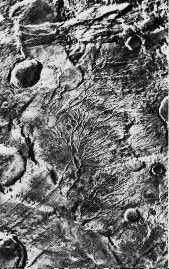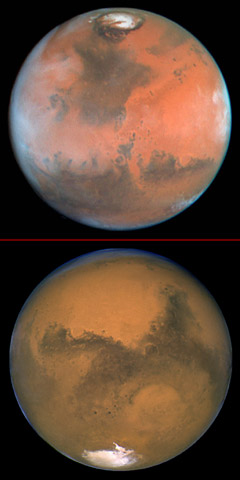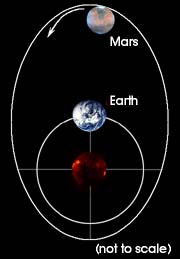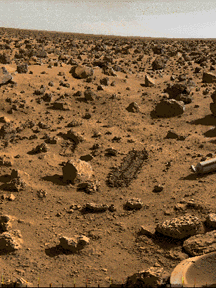This image shows evidence for running water on the surface of Mars.
Click on image for full size
Image from: NASA
Martian Water
There seems to be no running water on the surface of Mars today even though there is evidence for running water, including river channels such as those shown here, and there are frozen, icy polar caps. Features such as the streams shown here suggest that there was water present near the surface at some time in the Martian past. The atmosphere of Mars seems to contain a little water too. There are clouds and fog. Water in the atmosphere suggests that water still cycles between the ground and atmosphere today. Fog rises out of the ground and condenses back again, and water vapor in the atmosphere condenses and evaporates. In most respects, however, the possible Martian water cycle is nothing like it counterpart on Earth because Mars is so cold. Much of the water of Mars is frozen into the ground, and can only be released when Mars experiences a warming change in climate.
Mars is much smaller than the Earth, and Mars is farther from the sun that either the Earth or Venus. These facts mean that the surface of Mars cooled off more rapidly than the other two planets. In fact, recent measurements of the Martian surface show just how cold it can be. Because Mars is colder, it fits what some scientists call the "Goldilocks" phenomenon when it comes to the suitability of Mars to support life.
Future exploration of Mars will be directed at answering questions about exactly what has happened to the Martian water. Answers to these questions will help scientists better understand the Martian climate history.
You might also be interested in:

How did life evolve on Earth? The answer to this question can help us understand our past and prepare for our future. Although evolution provides credible and reliable answers, polls show that many people turn away from science, seeking other explanations with which they are more comfortable.
...more
There is plenty of evidence for running water on Mars. But this evidence suggests that the nature of flowing water on Mars is nothing like it's terrestrial counterpart. The evidence is in the form of:
...more
Unlike the Martian outflow channels, these Martian river valleys have many tributaries. These river valleys do not resemble their terrestrial counterparts either, however. The tributaries are very short,
...more
The North and South Poles on Mars are a lot like the polar regions on Earth. They are the coldest places on the planet. The temperatures in the winter can drop to -150° C (about -238° F). Both poles have
...more
This is probably what happened to Mars: an early warm period the inside of Mars cools off very fast volcanoes appeared, and the Tharsis Bulge is created changes in climate every once and awhile, which
...more
Scientists have two ideas about what happens to water on Mars. These ideas conflict with each other. 1.) Since warm weather is needed for the formation of the river channels & floods, episodes of warm
...more
This drawing illustrates the large differences in distance from the sun possible for Mars. (The drawing exaggerates the size scales a little). If conditions are just right, there are times when Mars can
...more
In spite of the fact that Mars has an atmosphere, the environment of Mars seems unfriendly toward life as we know it on earth. Mars is small, so there is not much gravity. For this reason, much of the
...more














